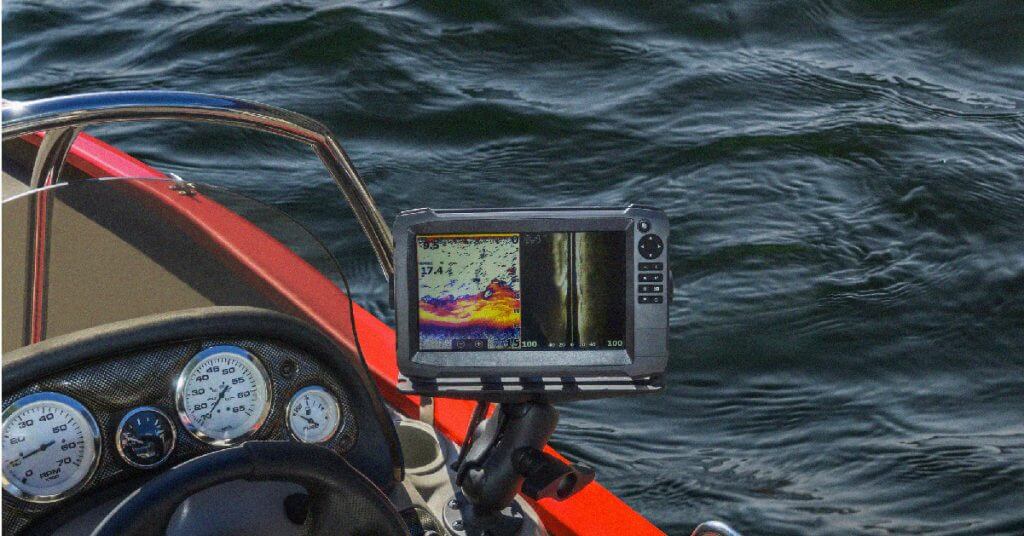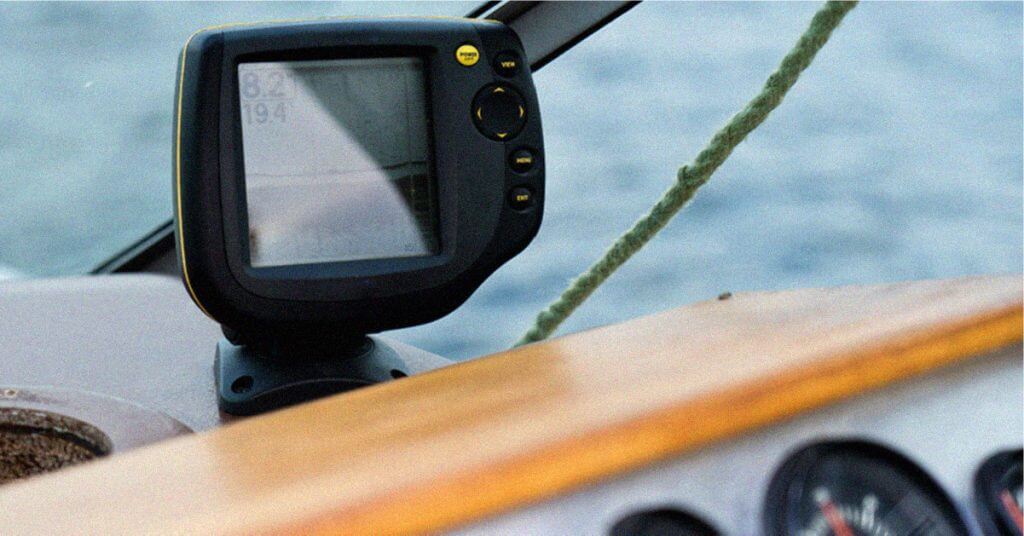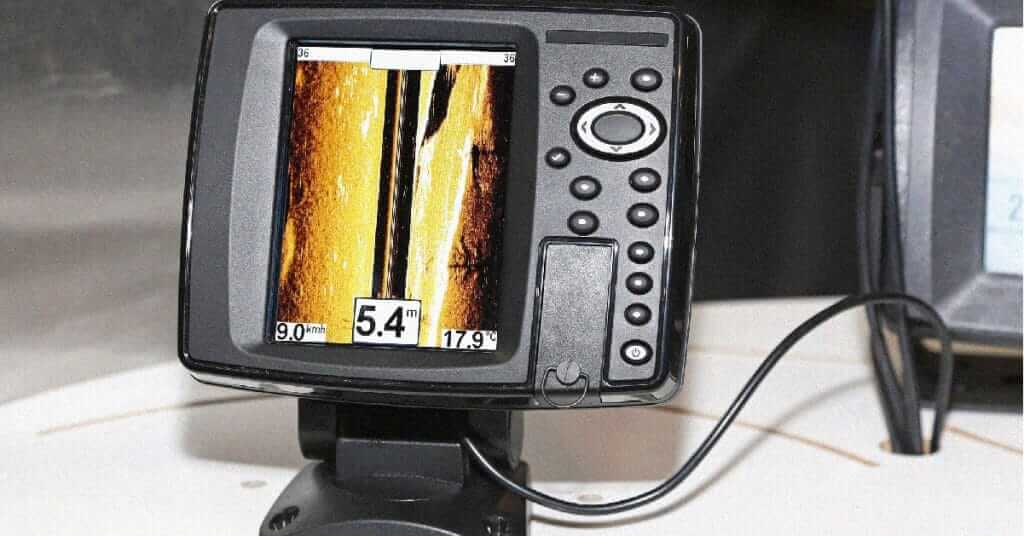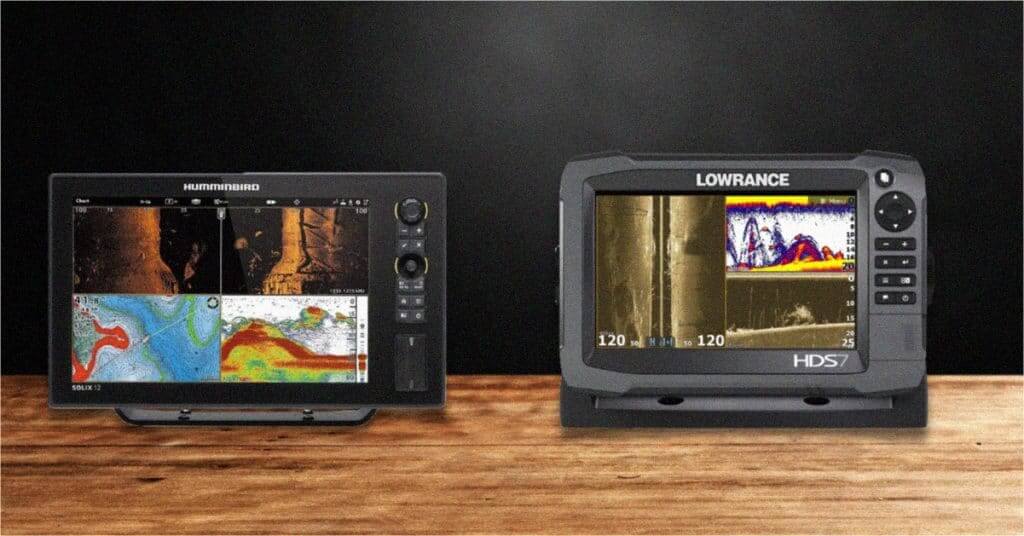Whether fishing is a weekend hobby or a serious business, the best fish finder GPS combo will ensure that you not only find more fish but catch more as well.
Best of all, the GPS capabilities allow you to track your location, chart waypoints, and create maps of all the lakes you frequent. It’s like showing up to the water with a treasure map.
So, drop your trolling motor in the water, set her nice and low, and get ready to see the most impressive GPS fish finders on the market.
Best Overall Chartplotting and Mapping
Humminbird Helix 7
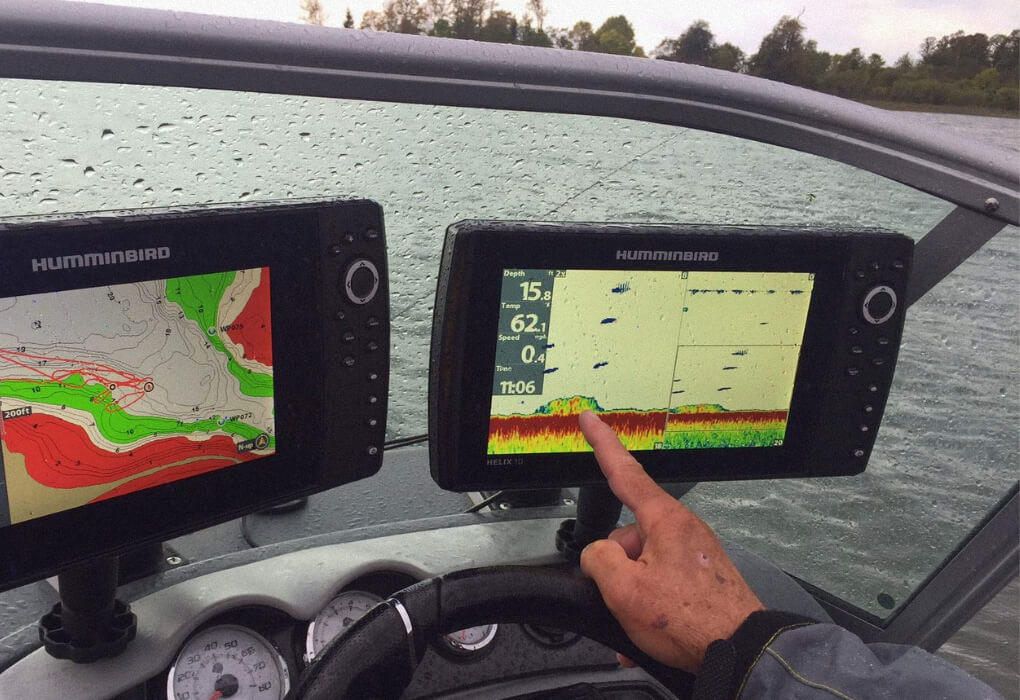
Specs
Pros
Cons
Why We Chose It
The Humminbird Helix 7 is the best overall because it is compatible with ALL, and I mean ALL, of the advanced sonar features an angler will need combined with GPS, chartplotting, and contour mapping of over 10,000 lakes plus the coastal waters of the US.
When you purchase the Helix 7, you get a great screen size perfect for most boats; with Active 360, you can see EXACTLY what’s below and around your boat as far as 125 feet away, so you won’t waste time fishing “dead water.”
You also get access to Mega+ down and side imaging. This is a fancy way of saying you get more depth than most other fish finders.
You’ll see everything happening around you and be able to decide where to cast based on that.
You name it; you can get it on the Helix.
It offers GPS, Autochart, Chartplotting, and contour mapping. I really like having the ability to drop a waypoint on a spot where I just caught a fish, but all GPS fish finders can do that.
What really impressed me while fishing was Autochart Live. It allowed me to create a real-time map of the small lake I was fishing in.
This is great for kayak anglers who fish water that’s rarely on maps or if you fish locations where the water depth often fluctuates.
It even offers one feature you may not have heard of, SmartStrike, and it’s one of the coolest features I’ve ever seen.
It allows you to input variables about the species you’re targeting, what time of year it is, what the weather is like, and if it’s windy or not.
The fish finder will then use algorithms based on its own memory of the specific water body you’re fishing, and it will present a map of where it thinks you should fish and what spots you should check out.
While this is an excellent fish finder, I found room for improvement.
Many of the features of this fish finder are premium upgrades, so you might as well pull out your calculator and keep it ready. Such as Active 360, Autochart Zero Line SD cards, and NMEA 2000 Networking.
This unit only includes the control head, screen cover, transom-mount transducer, power cable, mounting bracket, and mounting hardware.
The bare-bones models contain nothing more than a run-of-the-mill fish finder, and you’re better off with a cheaper model, such as the Lowrance Hook Reveal reviewed below if you’re not going to upgrade to premium features.
The Humminbird Helix might not be perfect, but what GPS depth finder is?
So if you’re an angler that loves to know every little detail about the area you’re fishing and you’ve always wanted a robot that tells you EXACTLY when and where to cast your lure, the Humminbird Helix 7 is the Supercomputer you need installed on your boat.
Don’t worry if a 7-inch screen isn’t the right size for your boat; you can opt for a smaller unit like the Helix 5 or a larger one like the Helix 10 and still enjoy the same features.
Read our review (of the 10″ unit) here: Humminbird Helix 10 review.
Best Mapping Techology
Lowrance Hook Reveal
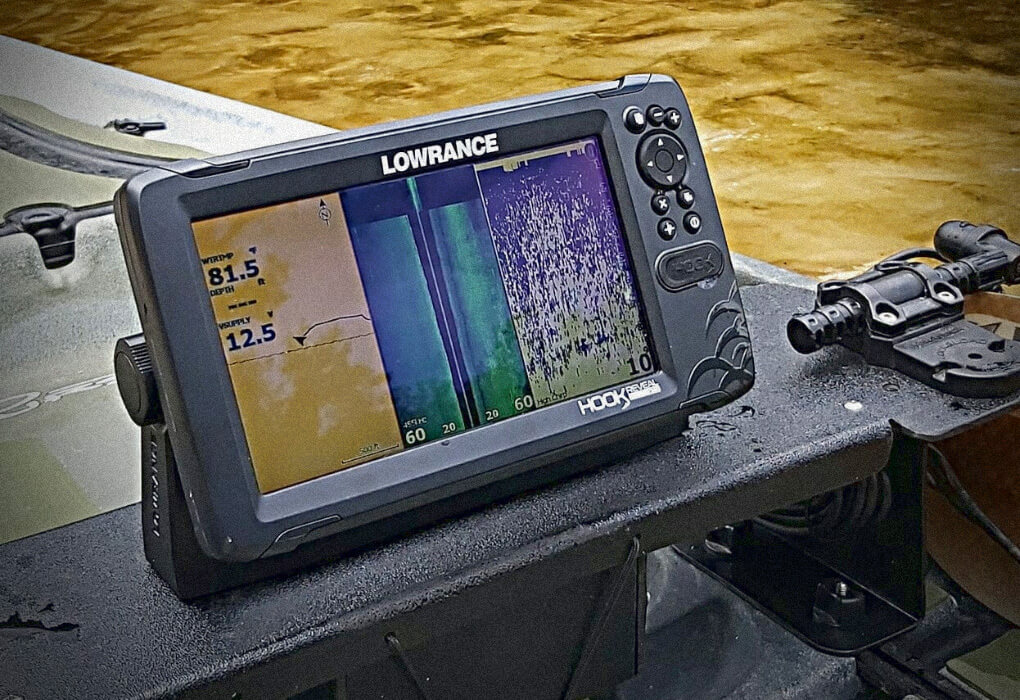
Specs
Pros
Cons
Why We Chose It
The Lowrance Hook Reveal has the best mapping technology I have ever used, hands down. Which is crazy, considering it’s not what I consider a high-end fish finder.
After testing it, my grandpa wanted to keep it installed on his boat, so there it sits.
If Chris Farley had had this unit installed on his boat in Almost Heroes, they would have had to rename the movie because this GPS fish finder is simple to operate and has incredible maps.
The first time I tested the Lowrance Hook Reveal 5, I couldn’t believe that it had a map of the large pond I was fishing, AND I could easily update the contour lines with Genesis Live.
Genesis Live mapping is some of the best in the business. You can create your own maps and contours as well. As you create travel paths, you’ll essentially be able to develop a plan each time you trek out to fish a specific lake.
You’ll have data about your previous visit, so you can plan around that.
It offers C-Map contours with high-resolution detail and one-foot contours of more than 5,000 lakes across the country.
If you’re fishing up North, it also has 9,400 Canadian lakes as well. However, you’ll have to purchase the optional SD card to access that information.
I also found the FishReveal technology to be helpful when trying to figure out if the arch is a fish or something else in the water.
While this fish finder, when paired with the Tripleshot transducer, is capable of downscan, sidescan, and CHIRP, I especially liked how easy it was to set up and navigate.
It took about 45 minutes to remove the old fish finder and install the Hook Reveal onto my grandpa’s boat, which I thought was well within reason.
My grandpa, who is not the most tech-savvy person, quickly figured out how the buttons work and easily navigated between the different screens.
I tested the Lowrance Hook Reveal 5, but it also comes in two other models, the Reveal 7 and Reveal 9. Like most fish finders, the only difference between the models is the screen size.
The two biggest downfalls I found while testing this unit were that it’s unable to upgrade to live sonar, so you’re stuck with what you get in the box.
The other thing is tech support from Lowrance isn’t the greatest. This seems to be true industry-wide, as larger companies rarely have great tech support.
Despite its downfalls, the array of sonar options, top-notch mapping, charting, and high-quality GPS technology, means you’re getting a great fish finder at a mind-blowingly low price when you purchase the Lowrance Hook Reveal.
Whether you’re a beginner looking to purchase your first depth finder or a veteran, this fish finder has everything the weekend warrior needs to help them locate fish.
Catching them is up to you; I’m afraid we still haven’t developed the legal technology to make them jump in the boat as you pass by…
Read our full review here: Lowrance Hook Reveal review.
Best for Offshore Fishing
Garmin Echomap UHD
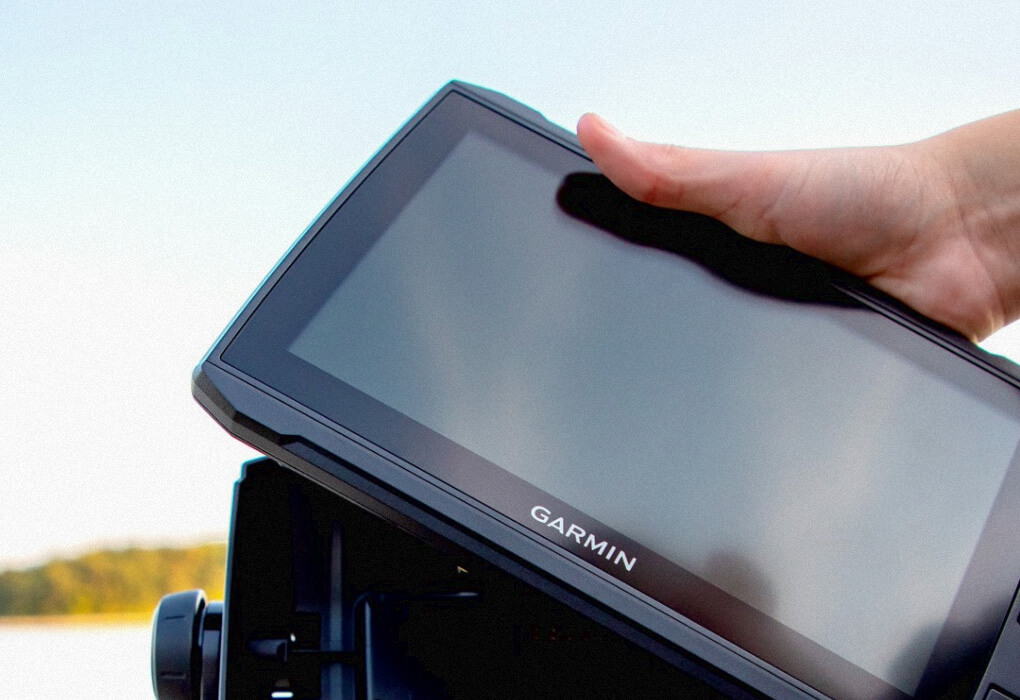
Specs
Pros
Cons
Why We Chose It
The Garmin Echomap UHD is the most advanced fish finder ever made by Garmin, one of the biggest names in fishing electronics.
It has precise maps for tens of thousands of waterways and is compatible with the latest sonar technology from Garmin, Panoptix Livescope.
Whether you’re an offshore fishing charter or cruise the shallows during the weekend, this unit does it all.
To start, you can choose the Worldwide Basemap, which is Garmin’s standard offering. It uses the same technology as its land GPS.
You’ll have access to ocean maps, river maps, and even streams as small as 100 feet in length. You even get access to land data like airports, urban areas, and territorial boundaries.
Bluechart G3 is the reason we rated this unit as the best for offshore fishing. If you fish saltwater, you’ll want this option.
These preloaded charts of all coastal waters on the east and west coast, the Gulf of Mexico, and the Great Lakes boast one-foot contours, high-res relief shading, depth ranges, and shallow water shading.
I especially liked the Lakevu G3 feature since I primarily fish lakes. This boasts 18,000 lakes with one-foot contours.
It comes with Navionics data. The fish finder will tell you the max depth in high-resolution color palettes, which you can adjust to your liking.
You even get access to various canal information throughout states like Florida.
I can’t forget about the sonar options.
If you want Panoptix Livescope, which is the latest and greatest sonar from Garmin that allows you to see the fish swimming under your boat and how they react to your lure, the Echomap UHD is simple to connect.
You have the option of three different transducers; I went with the Ultra high-def SideVU, ClearVu, and Traditional Chirp transducer, to see how the various sonars performed.
I’m happy to say I was so impressed, I installed the unit on my kayak, and it’s not coming off until I find something MUCH better.
The Garmin Echomap UHD is not all rainbows and unicorns because it is already an expensive unit, and the premium add-ons jack up the price.
While I have yet to deal with Garmin’s customer service, I’ve had many people tell me they were frustrated with the help they received. This doesn’t surprise me since Garmin is a giant corporation.
I ran into a problem when initially setting up the Echomap UHD; the sonar was turned off; this took about 10 minutes on YouTube to solve, plus another 45 minutes to install the unit onto my kayak (not including Livescope).
The Garmin Echomap UHD is a top-of-the-line mapping fish finder for people who need expert-level navigation using some of the best maps in the world paired with incredible sonar.
I know I can handle any body of water I venture onto with the Echomap UHD.
Read our full review here: Garmin Echomap UHD review.
Best Live Imaging
Lowrance HDS Live
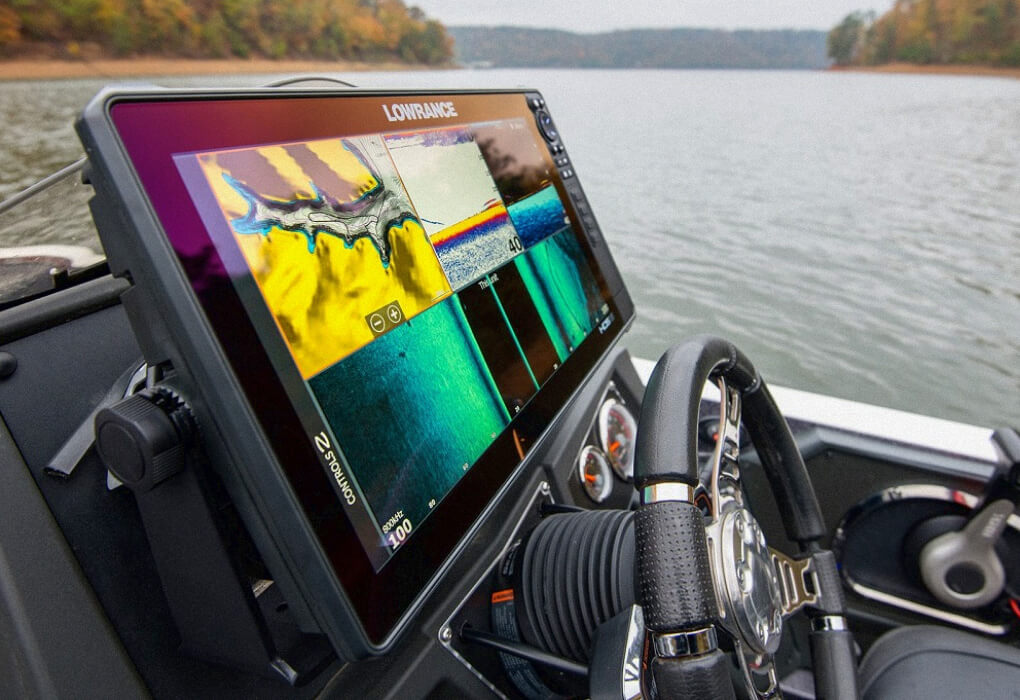
Specs
Pros
Cons
Why We Chose It
The Lowrance HDS Live really has it all. This piece of equipment is fully-loaded with every feature you could ever think of, a mind-blowingly clear screen, expert mapping, and it’s compatible with premium sonar.
If you’re an angler frustrated with how difficult it is to see your fish finder screen on sunny days, the SolarMAX HD screen on the Lowrance HDS Live gives you a crystal clear picture of your maps and what’s below the water’s surface.
This is the clearest screen I’ve ever seen on a fish finder. I had no problem seeing any part of it, even with the sun glaring down.
The SolarMAX HD touchscreen offers six different panels in some of the larger-sized screen models. It’s the most impressive screen on the market right now, and the brightness automatically adjusts based on the conditions.
I also like that it comes with the Active Imaging 3-in-1 transducer, which means you get higher-quality images at deeper depths, plus all the sonar you can think of.
Side imaging, down imaging, and traditional CHIRP, best of all – you can see it all at one time because of the 6-fold splitscreen option.
In my testing, the 3-in-1 transducer was great. It was simple to install and hook up, and it was easy to identify between fish and the structure underwater.
The HDS Live also gives anglers the ability to add on Lowrance LiveSight, which is Lowrance’s version of live sonar, so you can see what’s swimming beneath your boat. So if you want the latest sonar technology from Lowrance, you have that option with the HDS Live unit.
But this is a review about GPS, so let’s talk about it.
This unit comes with network compatibility, which means you can get live radar, camera features, Bluetooth, smartphone connectivity, chartplotting, live maps, and more all from this fish finder.
All the compatibility is great for fishing big water and when you need to connect to other units on your boat, while the live maps are perfect for the water that’s less traveled.
The HDS also features C-Map Genesis Live, which allows you to download exclusive maps that aren’t even available on the Navionics app.
The worst part about this fish finder is the price, but it’s tough to complain when you get so many benefits from using it. However, it can be overkill for the average angler who won’t use all these features.
Friend, the Lowrance HDS Live is the kind of fish finder you get when you’re really looking to make a statement. You’ll have a hard time finding one more capable of combining a crystal clear screen, top-level sonar, and the best mapping on the planet.
Pick one up today; you won’t regret it.
Read our full review here: Lowrance HDS Live review.
Best GPS Combo Under 500$
Garmin Striker Vivid 5cv
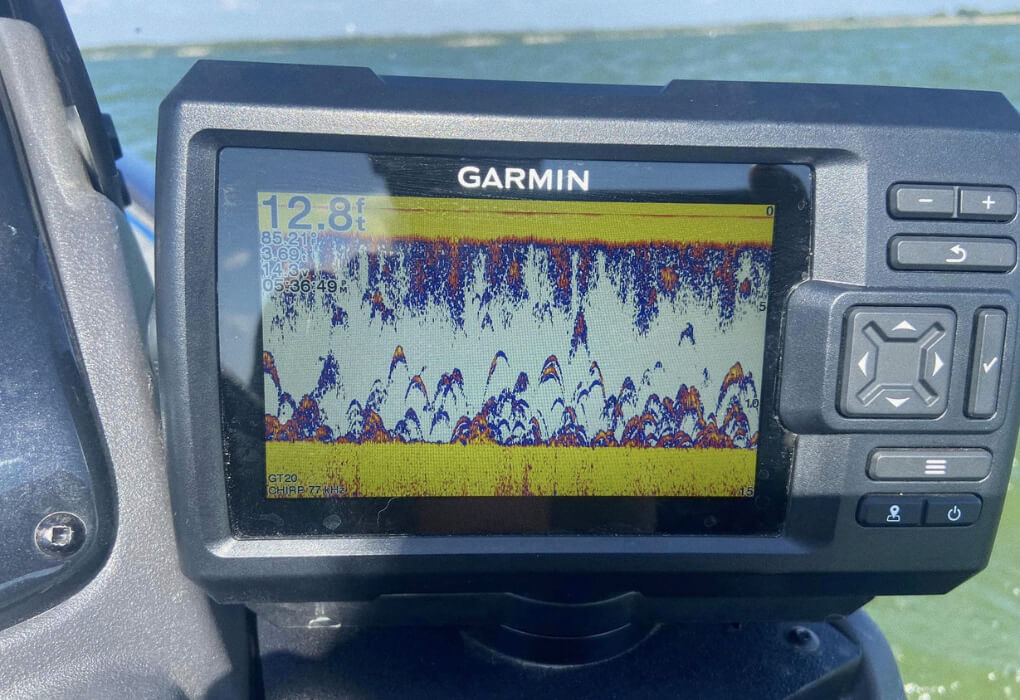
Specs
Pros
Cons
Why We Chose It
The Garmin Striker Vivid 5cv is the best GPS fish finder combo under $500 because it offers Quickdraw contouring, an enhanced screen, and ClearVU sonar.
It’s perfect for beginners to learn how to read sonar while still offering enough advanced features to keep dedicated anglers happy, such as Quickdraw contouring.
I love that you can instantly create HD fishing maps with 1-foot contours while using Quickdraw on nearly any body of water. This is perfect for kayak anglers who fish in a lot of uncharted waterways.
The Garmin Striker Vivid 5CV comes with SideVu and ClearVu, which offers versatility in terms of the types of views you can get of everything going on under the surface.
These views are Garmin’s side and down imaging; that’s just what they call it.
However, it’s not compatible with Panoptix Livescope.
So, this fish finder does have GPS, and it does have mapping, but it doesn’t have a MicroSD slot.
This means that you’re left with whatever comes with the fish finder unit, or you create with Quickdraw because you can’t download or purchase any additional mapping from Garmin.
It’s not the end of the world for most recreational anglers, but if you’re the kind of person who travels to fish a lot, this probably isn’t the unit for you.
All in all, the Garmin Striker Vivid 5cv is a budget model. It’s a stripped-down option of the premium Garmin fish finders for those on a tight budget.
However, it’s still a great choice for the weekend warrior looking to get into fish tech that needs custom mapping, a clear screen, and high-quality sonar. It’s a top choice for many small boat and kayak anglers.
Read our full review here: Garmin Striker Vivid review.
Best Portable Fish Finder GPS Combo
Garmin Striker 4
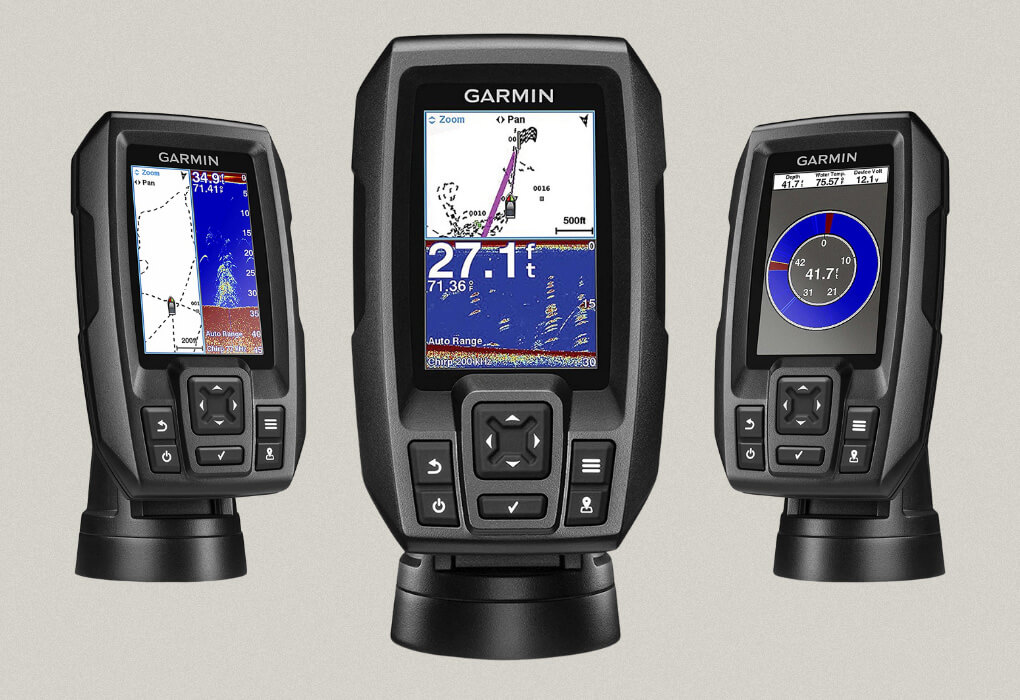
Specs
Pros
Cons
Why We Chose It
The Garmin Striker 4 is perfect for kayak and other anglers in need of a highly portable fish finder GPS Combo.
This was the first fish finder I ever bought, and I still use it from time to time on my kayak.
I love that it’s compact, incredibly budget-friendly, and you can set waypoints to mark your honey hole.
When paddling in my kayak, I love that this unit doesn’t get in the way, as my larger Echomap UHD does. It makes my paddling much more efficient.
It’s also very simple to remove from my kayak when transporting it; all I have to do is unplug a few wires and pop it out of the mounting bracket.
The worst part about this unit is the lack of maps. When you mark a waypoint, it’s on a blank white screen, and there’s no way to get maps loaded on the unit.
However, for the price, it’s difficult to complain because even a broke college student could afford to buy the Garmin Striker 4 (especially the non-portable-bundle version) if they stopped buying beer for a week or two.
The Garmin Striker 4 is the best portable fish finder GPS combo because it’s compact, stupid cheap, and can mark all of your favorite fishing spots.
Read our full review here: Garmin Striker 4 review.
If YouTube videos are more your speed, I’ve reviewed four of the best GPS fish finders on this list in this one
Testing Procedure
Here are the primary features I looked at while testing the best GPS fish finder combos:
- Screen Size: The size of the screen matters whether you’re in a small or big boat, so choosing the perfect size for your situation is critical. A smaller screen (<7”) in kayaks and Jon boats is needed to give you extra space. Whereas a large screen (9”+) for bass boats and larger vessels is needed so you can see it from anywhere on the boat.
- Mapping Capabilities: After testing many fish finders, I found that just because it has GPS doesn’t mean it has mapping capabilities. I prefer to have maps to help me identify exactly where to fish or the path I need to take to safely get back.
- Functionality: As I tested the different brands, I found some fish finders were easier to set up and learn than others. Personally, I prefer to use a GPS fish finder that’s user-friendly and easy to set up.
In order to test the following fish finders, I mounted them to my 12’ kayak or my grandpa’s 16’ Bass Tracker.
I did the installation with a little help from my grandpa, who is much more of a handyman than I am.
However, if you don’t feel comfortable with installing the unit, your local marina or boat mechanic will be happy to install it for you… for a price.
After the installation process was complete, I visited a small kayak-only lake and a much larger lake to compare the GPS and mapping features on different bodies of water.
Below are my findings.
How to Choose the Best Fish Finder GPS Combo
You’ve seen the top options available for purchase; now it’s time to determine how we’ll pick one.
There are a few different factors and any of these fish finders recommended in this article have advanced technology that you won’t find in some other models. Jump aboard as we dive into each of these buying factors.
Type of Sonar
The first and most important thing you should understand is the different types of sonar.
Having a high-quality fish finder has nothing to do with what brand it is, what size screen you have, where you mount it, or what color it is.
It has everything to do with the sonar.
There are four primary types of sonar. Some fish finders only have one of them, while others have all four.
Standard Sonar
The traditional types of fish finders are called conventional sonar. This means that the sonar waves run down into the water until they bounce off something. When they bounce, you know you’ve found something.
The problem with this type of sonar is at one time; they couldn’t tell you what they were bouncing off. So, you could have the catch of a lifetime or a patch of weeds in the water. You didn’t know the difference.
Chirp Sonar
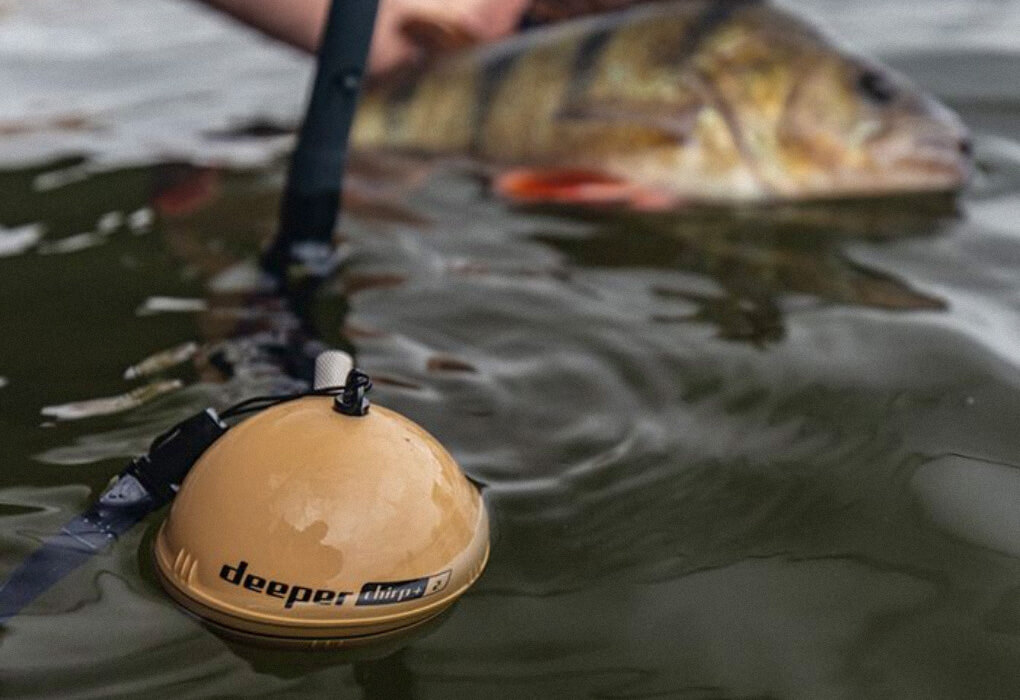
Chirp sonar functions a lot like standard sonar but in quick bursts instead. So, as opposed to sending a constant flow of sonar, it’ll send out frequent chirps that will help reset and pick up new movement as you’re moving along.
This isn’t necessarily more accurate but it provides a clearer picture so it’s easier for the angler to understand.
The reason is, if you notice that a certain object on the screen moves and another doesn’t even time the screen resets, you’ll know that the moving thing is a fish and the other arch isn’t.
Down Imaging
Down image fish finders are the most common, and instead of sending sonar down into the water to bounce, they use a cone that covers a certain amount of space beneath the water.
For example, if you’re trying to figure out an area to toss a jig, you might want to know how deep the fish are under the boat. A down-imaging fish finder would be ideal here. These are also the ideal choice for ice fishing.
Side Imaging
Side imaging or sidevü fish finders are the best of the best, and they usually come at a price tag to reflect that. If you want to see what’s going on all around the boat rather than just beneath it, this is the way to go.
For example, if there’s a column of weeds but you want to know if there are any fish on the other side to toss a topwater frog, the side imaging fish finder will send sonar horizontally towards that direction.
In some cases, you’ll hear words like TripleShot, Dual Beam, and others. These refer to combinations of imaging. TripleShot fish finders are the top choice because they offer Chirp, down imaging, and side imaging all in one.
Cone Angle
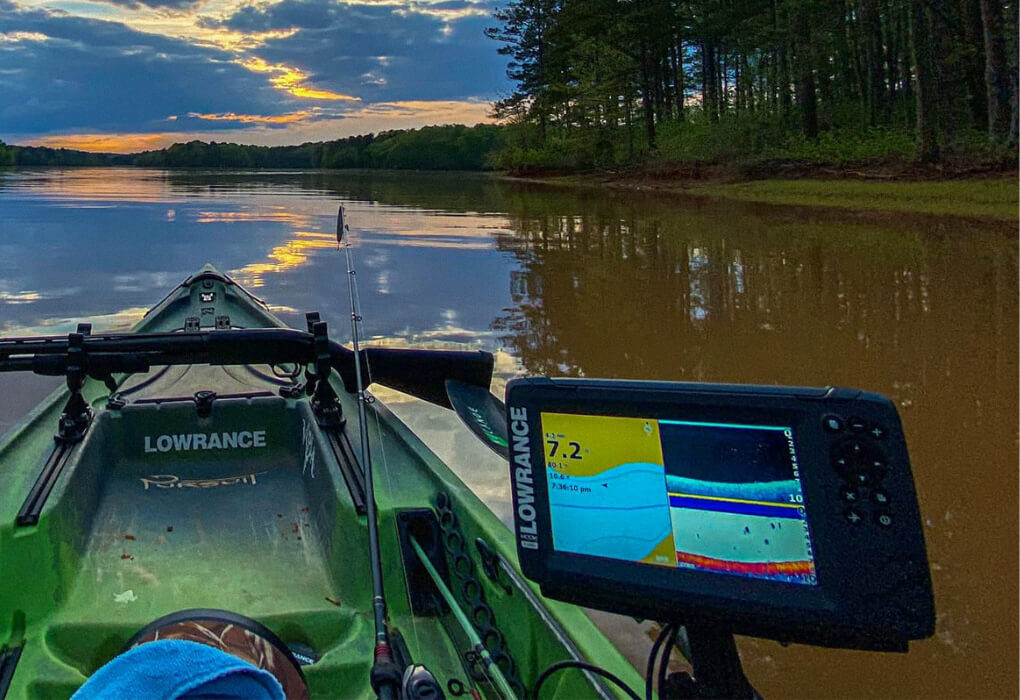
The angle of your cone is another important factor. The wider the cone the more area you can cover beneath the boat.
But keep in mind that larger isn’t always better. If you have a wider cone radius, it also means you have a less accurate signal.
What you want to pay attention to is the depth of your cone. Some fish finders have cone depths between 75-150 feet. That means that you’ll start to lose accuracy as you get close to those depths.
The deeper the cone will reach, the better you’ll perform in deep water. But, it will also increase your cost.
Dual-beam signals cover more area and many fish finders will allow you to control the width of your cone so you can zero in on fish or widen it out if you’re not seeing anything.
GPS Capabilities
The whole article is about depth finder GPS combos so GPS capabilities are obviously important. What you’re looking for are simplicity and accuracy.
You don’t need anything too fancy because it’ll end up being a useful feature that you’ll never touch.
As long as the GPS can accurately depict your location, you’re good to go. It’s also nice to have one that has Bluetooth connectivity so you can sync it with your phone. That’s a nice added feature.
Mapping and Plotting
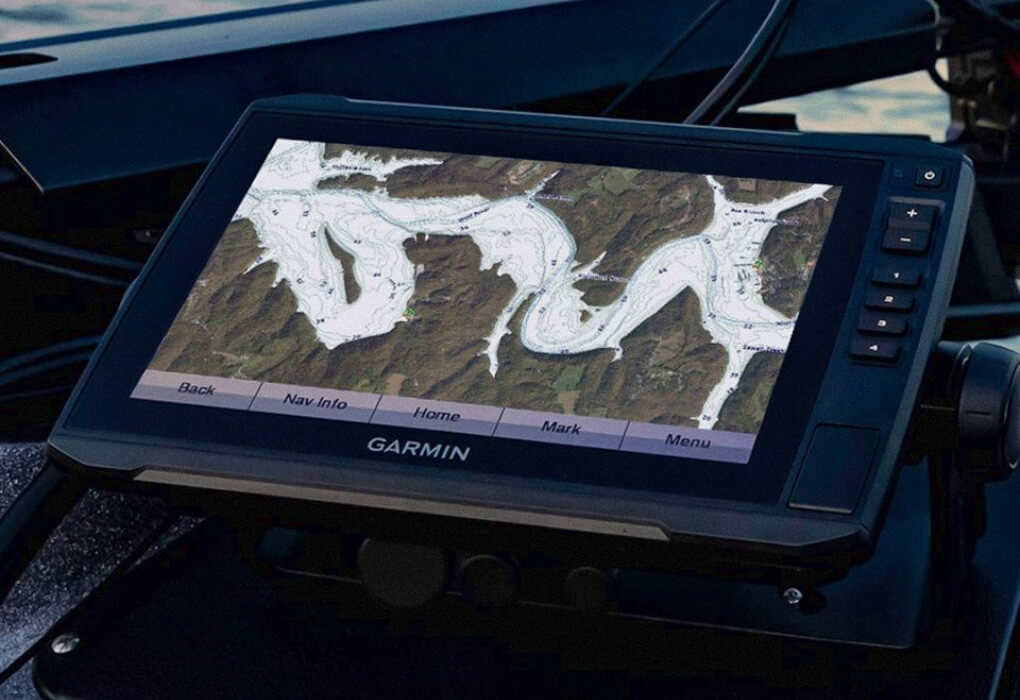
Plotting waypoints is great because you can mark down locations you caught something or areas that you want to revisit for whatever reason.
Most fish finders with internal GPS come with this feature as well and all of the options available here do.
Many of these fish finders also come with preloaded maps with lakes from all over the country already mapped for you. This is a great feature for fishing spots you’ve never been to before and tracking hot spots around the water.
Display Quality
The display is important because you’re paying a lot of money for something and you want to make sure you can see and read it. Make sure that the device you choose is easy to navigate, accurate, and simple to set up.
If you’re not tech-savvy, this will be even more important because some of these devices can get complicated.
Consider the type of screen you want as well. Most fish finders offer a color display because it’s easier to see contours that way.
If they have a backlight or glare adjustment, that’s an added bonus too. Look for an LCD split-screen display with a high pixel whenever possible.
Mounting
If you’re shopping around for a kayak fish finder, mounting will be an important factor. Make sure that when you shop, you get all the components you need to mount the device before you wake up to go fishing.
The worst thing is waking up and realizing that you’re missing something.
Many fish finders will require you to purchase additional parts and it can seem misleading based on the advertising. When you receive the device, check the parts and mount it as soon as possible.
Also, factor in the location of the transducer. Most of them are transom mount transducers which means they mount to the back of the boat to limit the amount of water they take.
In-hull mounted fish finders are the easiest and safest because you don’t need to put them outside the boat but many people think they’re not as accurate.
Keep in mind how saltwater may corrode the unit faster than freshwater as well.
Durability
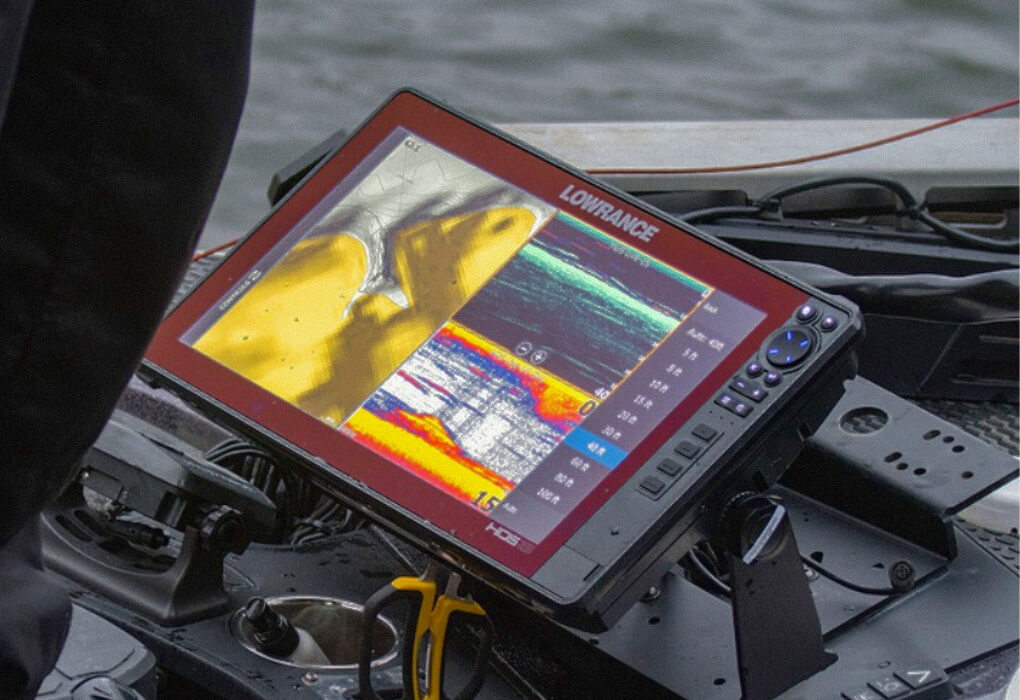
Durability is always a factor you should think about because some fish finders are more waterproof than others.
Make sure you understand that water-resistant doesn’t mean waterproof and most fish finders can’t get wet so you’ll want to mount them properly.
Some are also more portable than others. Some can get removed and stored in a fishing backpack or even a tackle box.
Power
Transducer power is calculated in RMS which is “root mean squared.” Most fish finders are around 500 RMS and that’s generally where you want to be.
Anything less than that won’t provide a clear image. The more power they have, the better they’ll work in deeper water as well.
Your frequency is an important factor that goes along with power. The higher the frequency, the less depth, and power you have. The lower the frequency, the more power, and depth. Keep these in mind as you choose.
When shopping based on durability, it helps to go with recommended brands. Garmin, Humminbird, Raymarine, and Lowrance, are all popular brand names.
Final Thoughts
The best fish finder GPS combo consists of a high-quality transducer with a wide-angle cone that provides clear and concise images.
It also offers a substantial GPS system with mapping capabilities so you can navigate the water and create waypoints.
It’s a tall order, but all the fish finders in this review will do just that quite well. However, the Humminbird Helix 7 does it the best.
I might add. If you’ve decided that you’re ready to work smarter and not harder, these devices will help you do just that.
Be sure to let us know what features matter most to you when buying a GPS fish finder combo, in the comment section.

